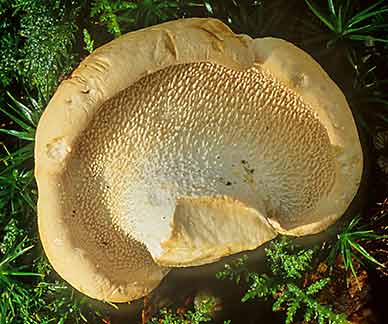Hedgehog Fungus (Hydnum repandum)

that give the species its common name
The Hedgehog Fungus (Hydnum repandum), shares its common name with at least one other fungus and that's the Bearded Tooth (Hydnum erinaceus) although our Hedgehog Fungus is sometimes distinguished by the addition of a prefix - Wood - and is sometimes also charmingly known as the Wood Urchin or Wood Hedgehog.
The name derivation for both, though, is clear, for neither has conventional gills nor pores on the under surface, but they instead rely on tooth-like spines for spore production.
Quite common in the New Forest, where it makes its autumnal appearance singly or in small groups in both broad-leaved and coniferous woodlands, Hydnum repandum is a relatively small fungus that reaches an absolute maximum of 15 centimetres across.
The fleshy, velvety cap is usually flattened or centrally depressed, and is cream or yellowish in colour. The relatively stout, short, whitish stem is often off-centre and somewhat lumpy at the base.
When cooked, this is an excellent edible fungus with a nutty taste and texture appreciated by many fungus foragers. When raw it is less enjoyed for the taste is noticeably bitter.
Warning: refer to a good, comprehensive fungus field guide to confirm identification, and only eat those species known without any doubt whatsoever to be edible - people have died after eating certain poisonous specimens.
References:
Mushrooms and other Fungi of Great Britain and Europe - Roger Phillips
The Mushrooms and Toadstools of Britain and North-western Europe - Marcel Bon
Fungi of Britain and Europe - Stefan Buczacki and John Wilkinson
The MacDonald Encyclopedia of Mushrooms and Toadstools - Giovanni Pacioni
Fungi of the New Forest: A Mycota - Edited by Gordon Dickson and Ann Leonard
A Passion for Mushrooms - Antonio Carluccio
More links
Other related links
Search this site

Sadly, 58 animals were killed - 35 ponies, 13 cows, 8 donkeys and 2 sheep, whilst a further 32 were injured - 3 pigs, 9 donkeys, 11 cows and 9 ponies.
(Forty-three accidents occurred in daylight, 15 at twilight and 101 in the dark. Twenty-seven accidents were not reported by the driver involved).
Here's just one horrific example - Three donkeys killed in collision with van at notorious New Forest blackspot (Advertiser and Times)

